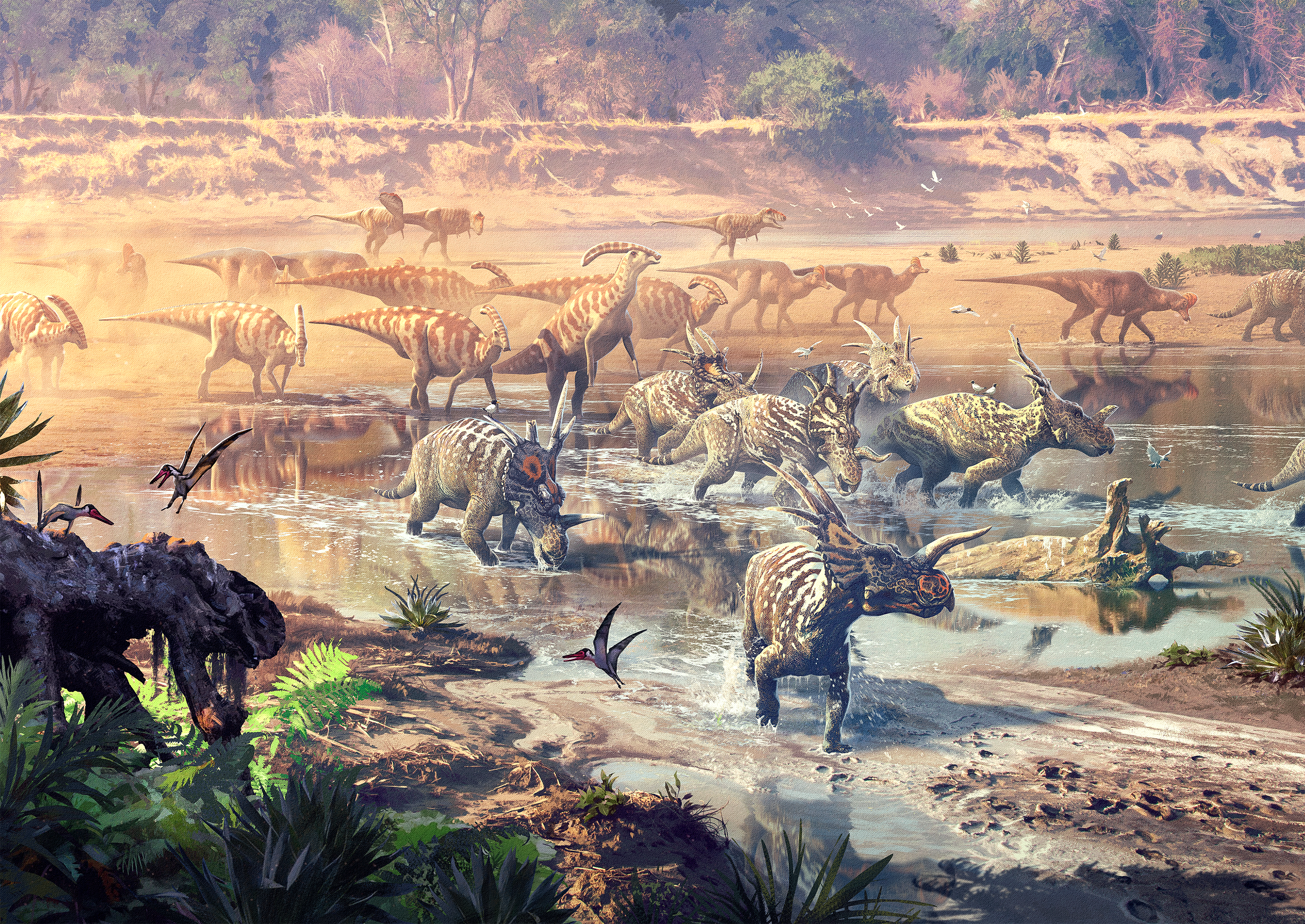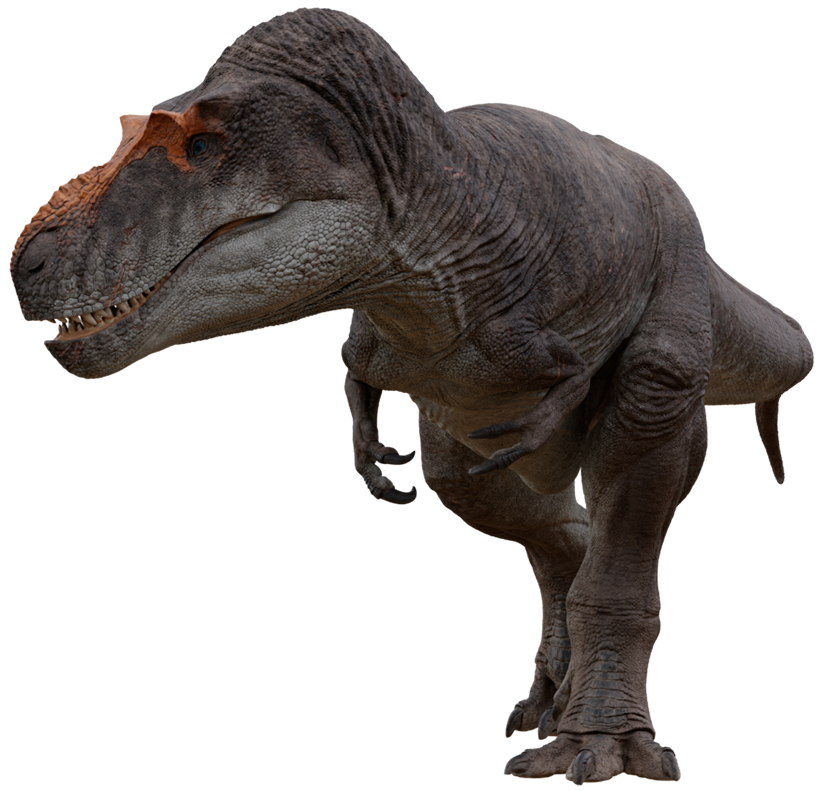The "Frightful" Tyrant Before T-rex
10 million years before T-rex, the top tyrannosaur in Alberta was Daspletosaurus. One of the better-known tyrannosaurs, this "frightful lizard" shines light on the evolution, ecology, and behavior of these awe-inspiring animals.
Overview: Tyrannosaurs were the dominant predators in North America during the Late Cretaceous, and 10 million years before the appearance of T-rex, the top tyrannosaur in Alberta was Daspletosaurus. It was discovered in the early 20th Century and named 50 years later, and today, it is one of the better-known tyrannosaurs. Many studies have been conducted focusing on Daspletosaurus’s place in the tyrannosaurid family tree, its apparent coexistence with fellow tyrannosaur Gorgosaurus, and the evidence Daspletosaurus and other tyrannosaurids provide about potential social behavior in these awe-inspiring animals.
Discovery: The holotype (original) specimen of Daspletosaurus torosus was discovered in 1921 near Steveville, Alberta, in rocks of the Oldman Formation by Charles Mortram Sternberg and identified as a specimen of the tyrannosaurid Gorgosaurus. Dale Russell described the specimen in 1970 and found it to be different from Gorgosaurus and more similar to T-rex, and he named it Daspletosaurus torosus. Daspletosaurus is Greek, meaning “Frightful Lizard” and torosus is Latin for “brawny” or “muscular”. Since then, at least one other specimen of D. torosus has been found in the Oldman Formation. Additional Daspletosaurus specimens from the Dinosaur Park Formation may be D. torosus or may be an as yet undescribed species. A second species, D. horneri was identified from the Two Medicine Formation of Montana in 2017. And a potential third species, D. wilsoni, was named from the Judith River Formation of Montana in 2022, though this species was found by others to potentially belong to D. torosus, which, if true, would extend D. torosus’s range down into Montana.
Evolution: Daspletosaurus was a tyrannosaurid theropod, meaning it was closely related to T-rex. The earliest evidence of tyrannosaurids dates to 82 million years ago (though the larger clade Tyrannosauroidea goes back to the Late Jurassic), though they likely appeared earlier. Daspletosaurus, which appeared around 77 million years ago, was an “advanced” tyrannosaurid, a tyrannosaurine, meaning it was closer to T-rex than to Albertosaurus. However, where exactly Daspletosaurus falls on the tyrannosaurid family tree is debated. Some studies have found it to be a more basal tyrannosaurine, while others have recovered it as more derived, closer-related to T-rex and Tarbosaurus. One study in 2003 made a case that Daspletosaurus is closely related to Tarbosaurus and that Daspletosaurus and Tarbosaurus are not as closely related to T-rex as commonly thought. Yet other studies have found Daspletosaurus to indeed be a close relative of both T-rex and Tarbosaurus, and some posit that the species of Daspletosaurus form a single anagenetic lineage leading to T-rex, i.e. the three species of Daspletosaurus form a lineage of progressing forms from D. torosus to T-rex, with D. wilsoni and D. horneri being intermediate forms. This has been criticized by other scientists however, and consensus on the placement of Daspletosaurus in the tyrannosaurid family tree has not yet been reached. Suffice it to say Daspletosaurus is a close relative and potential ancestor of T-rex which predated it by about 10 million years.
Description: Daspletosaurus had a basic tyrannosaurid body plan, bipedal, large robust head, long tail for counterbalance, long powerful legs, and short arms with two-fingered hands. Daspletosaurus was a large predator measuring 8.5–9 meters (28–30 ft) long and weighing 2–3 tonnes (2.2–3.3 tons). Its skull was over 1 meter (3 ft 3 in) long and powerfully built, and its jaws were lined with teeth that were both long and thick, adapted for puncturing deep into its prey and tearing off chunks of flesh and even crushing bone. Though not as strong as the jaws of its later relative T-rex, Daspletosaurus nevertheless had an immensely powerful bite, possibly the strongest of its day. Daspletosaurus had a small lacrimal crest (a small “horn” made from the lacrimal bone) over each eye. These were probably used for display.

Behavior and Ecology: Daspletosaurus lived on a floodplain in what is now Alberta, which was at the time sandwiched between the Rock Mountains and the western Interior Seaway. The region was volcanically active and the animals living there would have had to deal with occasional eruptions and ashfalls, intermittently devasting wildlife, but fertilizing the ground for new plant growth. It lived alongside numerous other dinosaurs, including herbivores like the hadrosaurs Parasaurolophus and Brachylophosaurus, the ceratopsids Albertaceratops, Chasmosaurus, Centrosaurus, ankylosaurs like Euoplocephalus, and others including pachycephalosaurs, ornithomimids, and therizinosaurs. In some parts of its range, Daspletosaurus seems to have overlapped with the albertosaurine tyrannosaurid Gorgosaurus, which was similar in size and probably hunted similar prey. Daspletosaurus had the stronger jaws and appears to have been less common, perhaps favoring the less common, and tougher ceratopsid prey, while Gorgosaurus may have preferred the more common and less heavily armed hadrosaurs. However, if this niche partitioning did exist, it is clear that it was not a hard rule, as a Daspletosaurus has been found with hadrosaur remains in its stomach. While both Daspletosaurus and Gorgosaurus are “northern tyrannosaurs” Daspletosaurus may have been more common in the south of its range while Gorgosaurus was more common further north. Thus, instead of true niche portioning, there may have instead been habitat partitioning with an overlap zone between the extremes of the two genera’s ranges.
Several Daspletosaurus fossils show evidence of social behavior. A young Daspletosaurus from the Dinosaur Park Formation shows healed facial bite marks from another Daspletosaurus. Similar bite marks are seen in an adult specimen from the same formation. These facial bite marks have also been found in other tyrannosaurs, including Gorgosaurus and Tyrannosaurus, and are thought to be due to intraspecific competition over territory or food, or for determining dominance within a social group. Currently, there is no consensus as to whether or not tyrannosaurs formed social groups, but a Daspletosaurus horneri bonebed from the Two Medicine Formation suggests its possible. The site preserved an adult, a small juvenile, and an intermediate sized juvenile, possibly suggesting a family group. Similar assemblages are also known from Albertosaurus and Teratophoneus suggest widespread potential gregariousness in tyrannosaurids, more evidence is required to say for certain. But it is nevertheless possible that Daspletosaurus was not just a top predator, but a team player as well, perhaps forming family packs like extant Harris Hawks.
Extinction and Legacy: When exactly Daspletosaurus went extinct is unknown, but it may have in part been due in part to a flooding event where the Western Interior Seaway, which had been receding during the time of Daspletosaurus, re-expanded, resulting in Daspletosaurus’s former stomping grounds being underwater by about 73 million years ago. Daspletosaurus was succeeded however by other tyrannosaurids, including the famous Tyrannosaurus rex, which appeared about 68 million years ago, and of which some consider Daspletosaurus to be an ancestor. Daspletosaurus can be seen in various museums, including the Canadian Museum of Nature in Ottawa, Ontario, Canada, the Rocky Mountain Dinosaur Resource Center in Woodland Park, Colorado, USA, the Museum of Natural History and Science at Cincinnati Museum Center, Cincinnati, Ohio, USA, the Milwaukee Public Museum in Milwaukee, Wisconsin, USA, and the Field Museum of Natural History in Chicago, Illinois, USA. Daspletosaurus has been featured in media including the second episode of the Discovery Channel documentary Dinosaur Planet, and the third episode of the similarly named 2011 BBC documentary Planet Dinosaur.
Daspletosaurus FAQ
Daspletosaurus size / How big was an Daspletosaurus?
See height, weight, and length.
Daspletosaurus height / How tall was Daspletosaurus?
Daspletosaurus was probably 3.2 meters (10.5 ft) tall.
Daspletosaurus weight / How much did Daspletosaurus weigh?
Daspletosaurus probably weighed about 2–3 tonnes (2.2–3.3 US tons).
How long was Daspletosaurus? / Daspletosaurus Length
Daspletosaurus grew to be 8.5–9 meters (28–30 ft) long.
What did Daspletosaurus eat?
Daspletosaurus ate meat, specifically other dinosaurs including hadrosaurs and ceratopsians.
What is Daspletosaurus’s closest living relative?
Like all dinosaurs, the closest relatives of Daspletosaurus are the only surviving lineage of dinosaurs today, the birds. Crocodilians, while not dinosaurs themselves, are also more distant cousins of dinosaurs.
Daspletosaurus family members / Daspletosaurus family / What kind of dinosaur was Daspletosaurus?
Daspletosaurus was a theropod (two-legged, mainly carnivorous dinosaurs) in the family Tyrannosauridae, and was close cousin of the larger and more famous Tyrannosaurus rex!
How many teeth did Daspletosaurus have?
Daspletosaurus had about six-dozen (72) teeth!
Where did Daspletosaurus live? / Where was Daspletosaurus found?
Daspletosaurus lived on the landmass of Laramidia (now western North America) and has been found in Alberta and Montana.
When did Daspletosaurus live?
Daspletosaurus lived about 77-75 million years ago during the Late Cretaceous Period.
What does Daspletosaurus mean? / Daspletosaurus name meaning
Daspletosaurus means “Frightful Lizard”.

